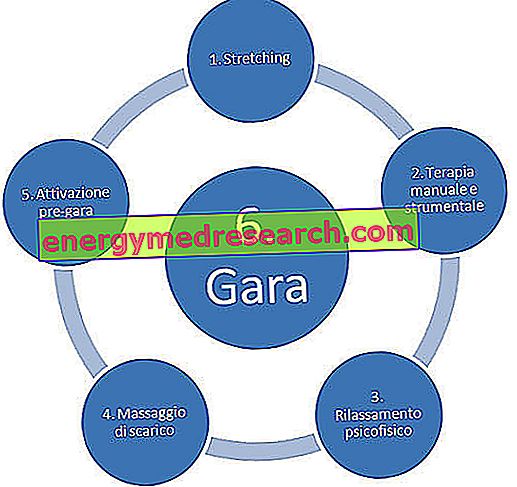Duloxetine is an antidepressant drug belonging to the serotonin and norepinephrine reuptake inhibitor (SNRI) class. It is an analogue of fluoxetine (a selective serotonin reuptake inhibitor or SSRI) synthesized by the pharmaceutical company Eli Lilly.

Duloxetine - Chemical Structure
Most likely, duloxetine is best known under the trade names Cymbalta® and Xeristar®.
Indications
For what it uses
The use of duloxetine is indicated for the treatment of:
- Depression;
- Generalized anxiety disorder;
- Diabetic neuropathic pain.
Warnings
Depression is associated with an increased risk of suicidal thoughts and / or behavior and self-harm. Before duloxetine performs its therapeutic action, 2-4 weeks of treatment may be necessary, therefore, patients should be carefully monitored until a significant improvement in the disease occurs.
Duloxetine should not be used in patients less than 18 years of age, because - in this category of patients - the drug increases the risk of suicide attempts and hostility (aggression, oppositional behavior and anger). However, if the doctor considers it absolutely necessary, he could also prescribe duloxetine to these patients.
Since duloxetine can cause drowsiness and dizziness, driving and using machines is not recommended.
Abrupt discontinuation of duloxetine treatment is not recommended as withdrawal symptoms may occur.
The use of duloxetine should be avoided - or carried out with great caution - in patients who present the following conditions:
- Renal disorders;
- Seizure crises;
- Manic disorders;
- Bipolar disorders;
- Glaucoma;
- Coagulation changes;
- Hyponatremia (low sodium levels in the bloodstream);
- Taking other medicines that can cause liver damage;
- Taking other medicines containing duloxetine.
If you are in any of these conditions, you must tell your doctor before starting duloxetine therapy.
Interactions
The use of duloxetine concomitantly with other drugs containing the same active ingredient should be avoided.
The concomitant intake of duloxetine and MAOI (monoamine oxidase inhibitors) must be absolutely avoided, due to the serious adverse effects that may arise. Before starting duloxetine therapy, a period of at least 14 days must elapse after the last intake of MAOIs. If, on the other hand, it is necessary to switch from a therapy based on duloxetine to a therapy based on MAOIs, it is necessary to allow a period of at least 5 days to elapse after the last duloxetine intake.
The co-administration of duloxetine and drugs that cause drowsiness - such as, for example, benzodiazepines, phenobarbital, antipsychotics, some painkillers, and antihistamines - should be avoided.
The simultaneous intake of duloxetine and drugs capable of increasing serotonin transmission must be avoided. Among these drugs, we recall:
- Triptans, drugs used to treat migraine;
- Tramadol, an opioid painkiller;
- Tryptophan,
- SSRIs, such as paroxetine and fluoxetine ;
- Venlafaxine, another inhibitor of serotonin and noradrenaline reuptake;
- TCA (tricyclic antidepressants), such as clomipramine, imipramine and amitriptyline ;
- Petidina, an opioid analgesic;
- Preparations based on St. John's Wort (or St. John's Wort), a plant with antidepressant properties;
- IMAO, like the moclobemide .
The concomitant administration of duloxetine and oral anticoagulants or platelet aggregation inhibitors could increase the risk of abnormal bleeding or bleeding.
Alcohol intake is not recommended during duloxetine treatment.
Side effects
Duloxetine can trigger various side effects. Incidence and intensity of these effects vary from patient to patient. This depends on the sensitivity that each individual has towards the drug.
The following are the main side effects that may occur following duloxetine therapy.
Allergic reactions
In sensitive individuals, duloxetine can trigger severe allergic reactions. Such reactions can cause dizziness and difficulty in breathing with swelling of the tongue and lips.
Suspension symptoms
If duloxetine treatment is stopped abruptly, so-called withdrawal symptoms can occur. These symptoms include:
- dizziness;
- Dizziness;
- Pins and needles;
- Sensations such as electric shock (especially in the head);
- Difficulty sleeping;
- Vivid dreams and nightmares;
- Headache;
- Feeling of restlessness;
- agitation;
- Anxiety;
- Irritability;
- Myalgia;
- Tremor;
- Fatigue;
- Drowsiness;
- Nausea or vomiting;
- Diarrhea;
- Excessive sweating.
Usually, these symptoms do not occur in severe form and disappear within a few days, but - should they occur - it is still necessary to inform the doctor.
Nervous system disorders
Duloxetine therapy may give rise to:
- Headache;
- dizziness;
- Difficulty sleeping;
- Poor quality of sleep;
- Abnormal dreams;
- agitation;
- Anxiety;
- Nervousness;
- fainting;
- Concentration disorders;
- Feeling of laziness;
- Tremors;
- Seizure crises;
- Insensitivity, including a feeling of numbness, tingling or tingling of the skin;
- Disorientation;
- Abnormal and uncontrollable twitching and spasms of the muscles;
- Psychomotor restlessness;
- Lack of coordination;
- Restless legs syndrome.
Psychiatric disorders
Duloxetine can cause hallucinations, mania, anger, aggressive or suicidal behavior.
Eye disorders
Treatment with duloxetine can cause visual disturbances and mydriasis (dilation of the pupils). Furthermore, the drug can promote the onset of glaucoma.
Gastrointestinal disorders
Following the intake of duloxetine, vomiting, diarrhea or constipation, burning or stomach pain, difficulty in digesting, accumulation of gas in the intestine, gastroenteritis and difficulty in swallowing may occur. In addition, blood may be emitted with vomiting or black faeces.
Disorders of reproductive and breast udder
Duloxetine therapy can cause a decrease in libido, difficulty or inability to reach orgasm and galactorrhea (abnormal milk secretion) in both women and men.
In female patients, the drug may cause abnormal vaginal bleeding, abundant, painful, irregular, prolonged, or poor or absent menstrual cycles.
In men, however, pain in the testicles or scrotum may occur, difficulty in having an erection and changes in ejaculation.
Hepatobiliary disorders
Treatment with duloxetine can cause inflammation of the liver, liver failure and promote jaundice.
Endocrine disorders
Duloxetine can trigger the syndrome of inappropriate secretion of the antidiuretic hormone (SIADH); this syndrome can - in turn - cause dehydration and hyponatremia.
The drug could also cause a decrease in thyroid function with a consequent feeling of tiredness and an increase in body weight.
Ear disorders
Duloxetine therapy can cause ear pain and tinnitus, a disorder characterized by the perception of sounds such as buzzing, hissing, clinking, whistling, etc.
Renal and urinary disorders
Duloxetine can cause kidney and urinary problems, such as difficulty or inability to urinate, painful urination, nocturia (need to interrupt night-time sleep to urinate), increased frequency of urination or reduction in urinary flow.
Skin and subcutaneous tissue disorders
Treatment with duloxetine can cause hives and photosensitivity reactions. More severe skin reactions may also occur, such as Stevens-Johnson syndrome (a more severe variant of polymorphic erythema).
Serotonin syndrome
Duloxetine can trigger this syndrome, especially if it is taken together with other medicines that can increase serotonergic transmission.
The syndrome can also be defined as a serotonin poisoning and is caused by excessive serotonin activity in the central nervous system. Intoxication can occur in live, moderate or severe form.
Some of the symptoms that can occur are euphoria, drowsiness, restlessness, feeling of drunkenness, headache, fever, increased sweating, muscle stiffness, myoclonia (short and involuntary contraction of a muscle or a group of muscles), rhabdomyolysis (cell rupture of skeletal muscle and subsequent release into the bloodstream of substances present in the musculature) and seizures. Some patients may even enter a state of shock, with body temperatures above 40 ° C.
Other side effects
Other side effects that may arise following treatment with duloxetine are:
- Dry mouth;
- Lack of appetite;
- Sensation of constriction in the throat that causes hoarse voice;
- Nasal hemorrhages;
- Increased sweating;
- Increased thirst;
- Body weight loss;
- Fatigue;
- Increased blood pressure;
- Palpitations;
- Tachycardia;
- Chest pain.
Overdose
If overdose of duloxetine is taken, somnolence, vomiting, convulsions, serotonin syndrome and coma may occur. If duloxetine overdose is suspected, contact your doctor immediately and go to the nearest hospital.
Action mechanism
Duloxetine is a selective inhibitor of serotonin (5-HT) and noradrenaline (NA) reuptake. These two monoamines are produced inside the respective presynaptic nerve endings and released into the synaptic wall (the space present between the presynaptic and postsynaptic termination) following the reception of certain stimuli.
Once in the synaptic space, 5-HT and NA interact with their postsynaptic receptors expressing their biological action. Afterwards, they bind to transporters assigned to their reuptake (SERT for serotonin and NET for noradrenaline) and are reported inside the presynaptic nerve termination.
Duloxetine inhibits both NET and SERT with high affinity, binding to them instead of endogenous monoamines. The inhibition of these transporters causes serotonin and noradrenaline to remain in the synaptic space for a prolonged time, thus allowing them to continue interacting with their receptors. Continuous receptor interaction results in an increase in the serotoninergic and noradrenergic signal, with consequent improvement in the pathologies treated.
Mode of Use - Posology
Duloxetine is available for oral administration in the form of capsules. The capsule should be taken whole, without chewing and with the help of a glass of water.
The duloxetine dosage must be established by the doctor on an individual basis.
The doses of drug usually given are given below.
Depression and diabetic neuropathic pain
The duloxetine dose usually used is 60 mg of drug per day. The doctor, however, may decide to vary the dose in order to adapt it to the needs of each patient.
Generalized anxiety disorder
The usual starting dose of duloxetine is 30 mg of drug per day, then increased to 60 mg. The dose can be increased up to 120 mg.
In any case, the doctor may decide to vary the dosage to better adapt it to the patient according to his response to the therapy.
Pregnancy and breastfeeding
The use of duloxetine - or similar drugs - could cause damage to the newborn if taken during pregnancy, especially during the last trimester. In fact, it could increase the risk of the onset of persistent pulmonary hypertension of the newborn (PPHN) manifested by an increase in the respiratory rate and a bluish complexion of the skin. In addition, the newborn may develop symptoms such as difficulty in falling asleep or feeding, difficulty breathing, cyanosis, unstable body temperature, vomiting, constant crying, muscle stiffness or weakness, lethargy, tremors, nervousness or seizures. Usually, these symptoms occur within 24 hours of birth.
The use of duloxetine in breast-feeding mothers is not recommended.
In any case, pregnant women - established or presumed - and breastfeeding mothers must necessarily consult a doctor before taking duloxetine.
Contraindications
The use of duloxetine is contraindicated in the following cases:
- Known hypersensitivity to duloxetine;
- In patients suffering from liver and / or kidney diseases;
- In patients already treated with MAOIs or who have finished their MAOI therapy for less than two weeks;
- In patients taking fluvoxamine, another antidepressant drug;
- In patients who are taking ciprofloxacin or enoxacine (medicines used to treat certain types of infections);
- In patients who are taking other drugs containing duloxetine;
- In pregnancy and during lactation.
Duloxetine and stress urinary incontinence
Duloxetine can also be used for the treatment of stress urinary incontinence in women. This disorder is characterized by the involuntary release of urine during physical exertion or during activities such as laughing, coughing, sneezing or lifting weights.
Duloxetine is used to treat this medical condition because it appears to be able to increase the strength of the muscles responsible for retaining urine.
The starting dose of duloxetine usually administered is 20 mg of drug, to be taken twice a day. The dose is then increased to 40 mg, to be taken twice a day.
For the treatment of this disorder, duloxetine is marketed under the name Yentreve®.



